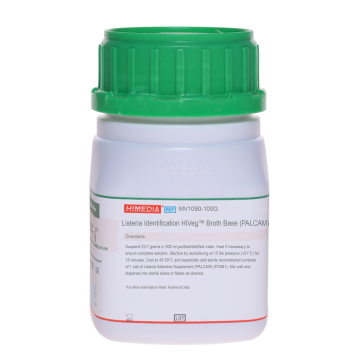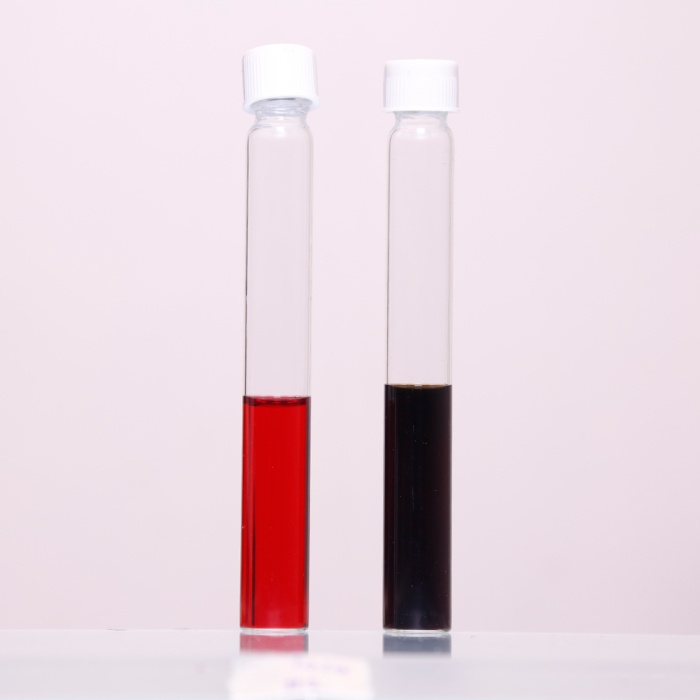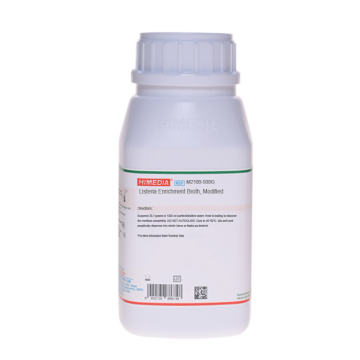 Your enquiry has been submitted
Your enquiry has been submitted
LPM Agar Base
Intended Use:
Recommended for isolation and cultivation of Listeria monocytogenes from food and dairy products.
Composition**
| Ingredients | g/L |
|---|---|
| Tryptone | 5.000 |
| Peptone | 5.000 |
| HM peptone B # | 3.000 |
| Glycine anhydride | 10.000 |
| Lithium chloride | 5.000 |
| Sodium chloride | 5.000 |
| Phenylethyl alcohol | 2.500 |
| Agar | 15.000 |
| Final pH (at 25°C) | 7.3±0.2 |
**Formula adjusted, standardized to suit performance parameters
# Equivalent to Beef extract
Directions
Suspend 50.50 grams in 1000 ml purified / distilled water. Heat to boiling to dissolve the medium completely. Sterilize by autoclaving at 15 lbs pressure (121°C) for 12 minutes. Cool to 45-50°C and aseptically add rehydrated contents of 1 vial of MX Selective Supplement (FD151). Mix well and pour into sterile Petri plates.
Principle And Interpretation
The first reported foodborne outbreak of listeriosis was in 1985 (1) and since then, microbiological and epidemiological evidence from both sporadic and epidemic cases of listeriosis has shown that the principal route of transmission is via the consumption of foodstuffs contaminated with Listeria monocytogenes (2). The organism has been isolated from commercial dairy and other food processing plants, and is ubiquitous in nature, being present in a wide range of unprocessed foods and in soil, sewage and silage and river water (3). Listeria species grow over a pH range of 4.4 to 9.6, and survive in food products with pH levels outside these parameters (4). Motility is most pronounced at 20°C.
L. monocytogenes is a gram-positive foodborne human pathogen responsible for serious infections in pregnant women that may ultimately result in abortion, stillbirth, birth of child with meningitis or primary bacteremia in adults and juveniles. Lee and McClain (5) developed LPM Agar, which is a modification of McBride Listeria Agar. It enhances the recovery of low numbers of L. monocytogenes from mixed microflora in samples. APHA also recommends this medium for food and dairy sample testing (6,4).
In LPM Agar Tryptone, Peptone and HM peptone B are sources of nitrogen, vitamins and minerals. Sodium chloride maintains the osmotic balance of the medium. Glycine anhydride improves recovery of Listeria. Lithium chloride, moxalactam and phenyl ethanol aids in suppression of both gram-positive and gram-negative organisms including Staphylococcus, Proteus and Pseudomonas species. Listeria monocytogenes show blue-green iridescence when examined with oblique transmitted light (7,8).
Type of specimen
Food and dairy samples
Specimen Collection and Handling
For liquid samples, pipette 25 ml sample in to 225 ml Listeria Enrichment Broth in 500 ml flask and mix well by shaking. For solid samples, weigh 25 grams into a stomacher bag and add 225 ml of enrichment broth. Mix the sample by stomaching for 2 minutes and incubate the mixture in the plastic bag at 30°C. After incubation for 24 hours and again at 48 hours, the enriched culture is streaked onto LPM Agar (M1228). Incubate at 35°C for 48 hours and presumptive Listeria colonies are selected under 45°C transillumination. After use, contaminated materials must be sterilized by autoclaving before discarding.
Warning and Precautions :
Read the label before opening the container. Wear protective gloves/protective clothing/eye protection/face protection. Follow good microbiological lab practices while handling specimens and culture. Standard precautions as per established guidelines should be followed while handling specimens. Safety guidelines may be referred in individual safety data sheets.
Limitations :
- The medium is not differential, so further biochemical testing is required for identification between Listeria species.
Performance and Evaluation
Performance of the medium is expected when used as per the direction on the label within the expiry period when stored at recommended temperature.
Quality Control
Appearance Cream to light yellow homogeneous free flowing powder
Gelling Firm, comparable with 1.5% Agar gel
Colour and Clarity of prepared medium Light yellow coloured clear to slightly opalescent gel forms in Petri plates
Reaction Reaction of 5.05% w/v aqueous solution at 25°C. pH: 7.3±0.2
pH 7.10-7.50
Cultural Response Cultural characteristics observed with added MX Selective Supplement (FD151) after an incubation at 35-37°C for 24-48 hours.
| Organism | Inoculum (CFU) | Growth | Recovery |
|---|---|---|---|
| Escherichia coli ATCC 25922 (00013*) | >=104 | inhibited | 0% |
| Listeria monocytogenes serovar 1 ATCC 19111 (00020*) | 50-100 | good-luxuriant | >=50% |
| Listeria monocytogenes ATCC 19112 | 50-100 | good-luxuriant | >=50% |
| Listeria monocytogenes ATCC 19117 | 50-100 | good-luxuriant | >=50% |
| Pseudomonas aeruginosa ATCC 27853 (00025*) | >=104 | inhibited | 0% |
| Staphylococcus aureus subsp. aureus ATCC 25923 (00034*) | >=104 | inhibited | 0 |
Key: (*) Corresponding WDCM numbers.
Storage and Shelf Life
Store between 10-30°C in a tightly closed container and the prepared medium at 2-8°C. Use before expiry date on the label. On opening, product should be properly stored dry, after tightly capping the bottle in order to prevent lump formation due to the hygroscopic nature of the product. Improper storage of the product may lead to lump formation. Store in dry ventilated area protected from extremes of temperature and sources of ignition. Seal the container tightly after use. Product performance is best if used within stated expiry period.
Disposal
User must ensure safe disposal by autoclaving and/or incineration of used or unusable preparations of this product. Follow established laboratory procedures in disposing of infectious materials and material that comes into contact with sample must be decontaminated and disposed of in accordance with current laboratory techniques (9,10).
Reference
- Wehr H. M., 1987, J. Assoc. Off. Anal. Chem., 70:769.
- Bremer P. and Osborne C., 1995, J. Food Prot., 58:604.
- Patel J. R., Hwang C. A, Beuchat L. R, Doyle M. P. and Brackett R. E., 1995, J. Food Prot., 58:244
- Salfinger Y., and Tortorello M.L., 2015, Compendium of Methods for the Microbiological Examination of Foods, 5th Ed., American Public Health Association, Washington, D.C.
- Lee W. H. and McClain D., 1986, Appl. Environ. Microbiol., 52:1215.
- Marshall R. T., (Ed.), 1992, Standard Methods for the Examination of Dairy Products, 16th Ed., APHA, Washington, D.C.
- Bearns R. E. and Girard K. F., 1959, Am. J. Med. Technol., 25:120.
- Murray P. R., Baron J. H., Pfaller M. A., Jorgensen J. H. and Yolken R. H., (Ed.), 2003, Manual of Clinical Microbiology, 8th Ed., American Society for Microbiology, Washington, D.C.
- Isenberg, H.D. Clinical Microbiology Procedures Handbook 2nd Edition.
- Jorgensen, J.H., Pfaller, M.A., Carroll, K.C., Funke, G., Landry, M.L., Richter, S.S and Warnock., D.W. (2015) Manual of Clinical Microbiology, 11th Edition. Vol. 1.
| Product Name | LPM Agar Base |
|---|---|
| SKU | M1228 |
| Product Type | Regular |
| Physical Form | Powder |
| Origin | Animal |
| Packaging type | HDPE |
| References | 1. Lee W. H. and McClain D., 1986, Appl. Environ. Microbiol., 52:1215. |
| Customized Product Available | No |












